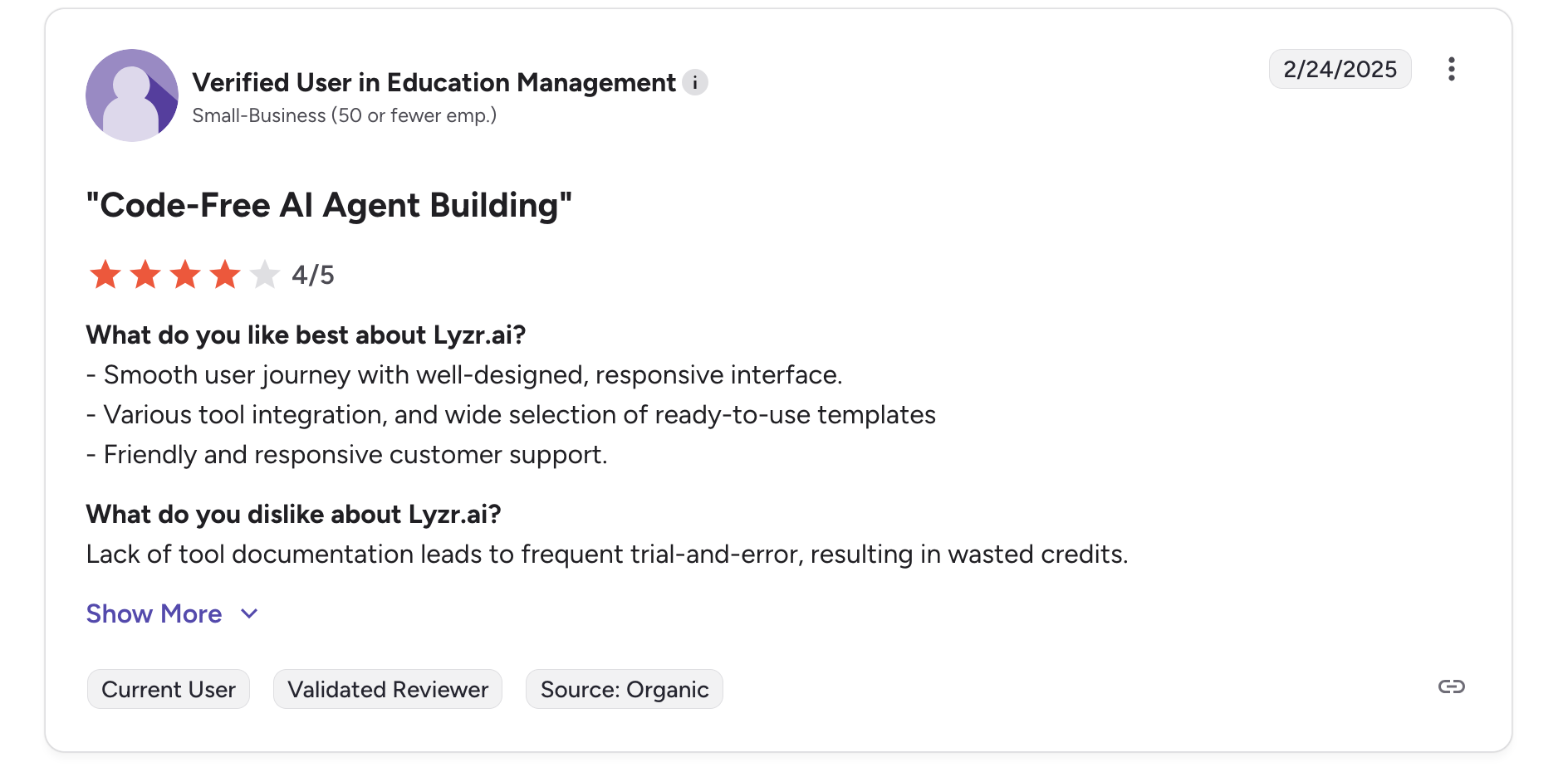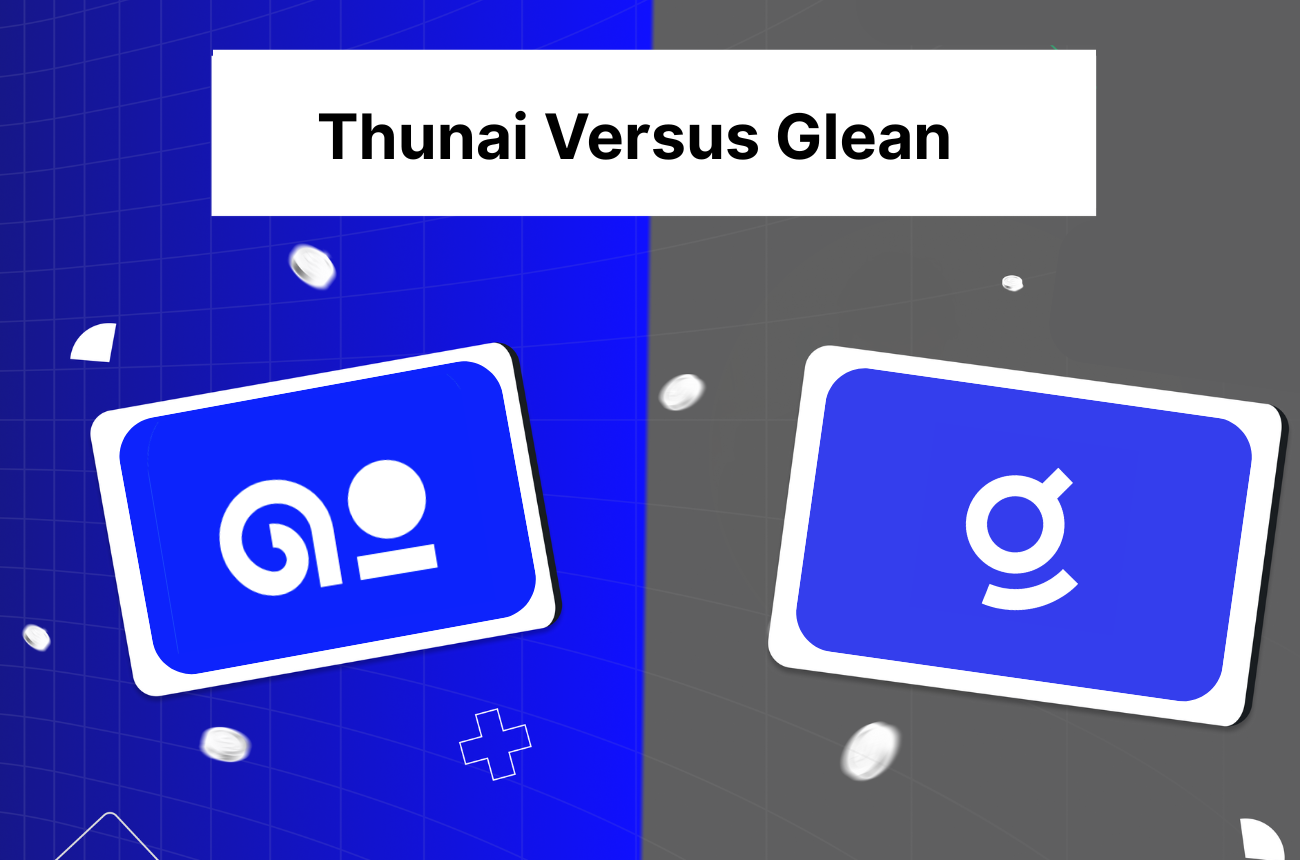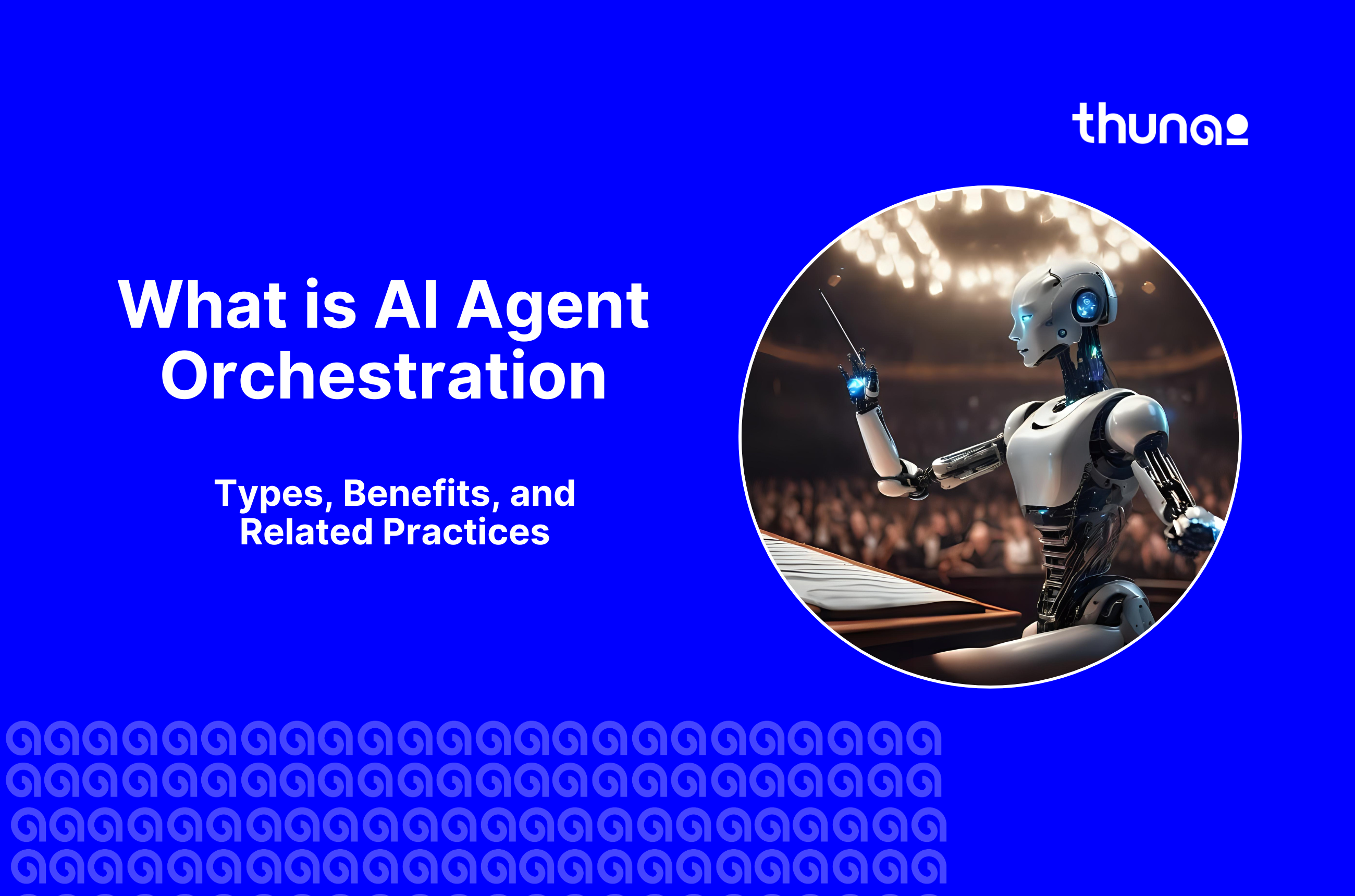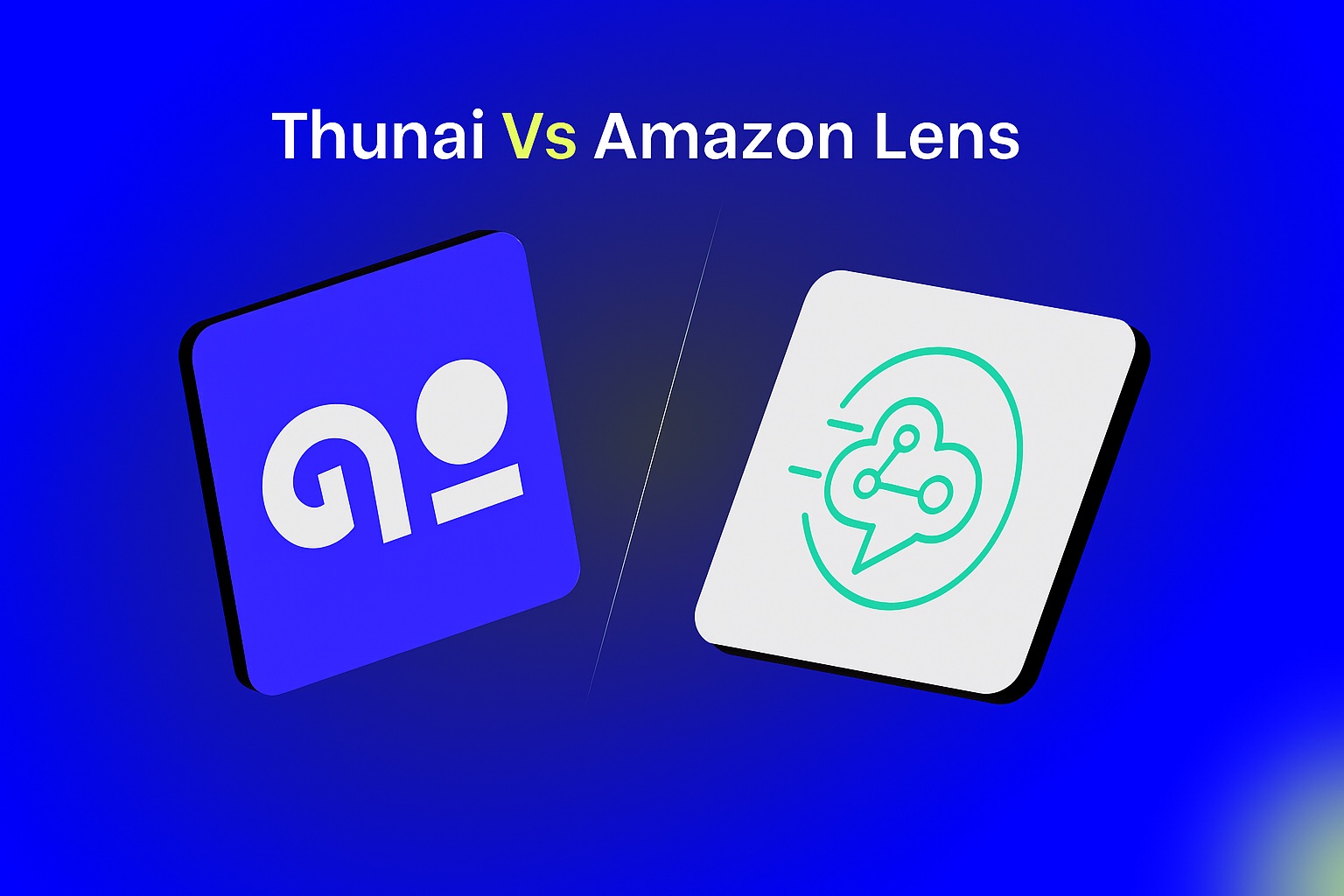Thunai vs. Lyzr: An In-Depth Comparison for Businesses

.png)

Thunai learns, listens, communicates, and automates workflows for your revenue generation team - Sales, Marketing and Customer Success.
TL;DR
Summary
- Lyzr AI is a low-code platform where technical teams must build, test, and deploy agents using its Agent Studio, APIs, and SDKs.
- Thunai offers ready-to-use applications — including a Meeting Assistant, Omnichannel AI agents for customer support (Thunai Omni), and proactive Revenue AI — available from day one.
- Thunai is a finished, business-ready platform with out-of-the-box AI applications, while Lyzr serves as a powerful developer studio built for technical teams to create custom solutions.
Are you using Lyzr AI? You might have been interested in its ambitious Agentic OS vision.
It is a decent tool for developers. But is it too rigid?
Lyzr AI still requires your technical team to build agents from a low-code studio, forcing you into a trial-and-error process.
A process that can lead you to wasting AI credits. However, if you want to change that, here’s how…
What is Thunai AI?
Thunai AI is an enterprise AI orchestration platform that improves CX and revenue. Thunai, as an agentic AI platform, is designed to work for your business from day one with no-code AI agents.
At the center of this platform is the Thunai Brain. This is not just a simple database. It is a central, living intelligence.
Thunai’s knowledge base unifies all your company knowledge. This includes documents, spreadsheets, videos, and even live application data.
From there, Thunai has ready-to-use systems that are powered by this knowledge base:
- Thunai Omni: A complete system for handling all customer interactions across voice, chat, and email. It analyzes sentiment in real time and allows for smooth AI-to-human handovers.
- Thunai Meeting Assistant: An active participant that joins your calls, supplies real-time transcription, and acts as a co-pilot, pulling live answers from the Brain during the meeting.
- Revenue AI and Reflect AI: Proactive modules that find new sales opportunities by listening to calls and EVEN assist product development teams by monitoring your product's health by pulling data from Jira and customer chats.
What is Lyzr AI?
When you think about building custom agents, you need a tool made for developers. Lyzr AI is a platform made for enterprises.
Lyzr AI is for building, deploying, and managing generative AI agents. It is an ideal choice for companies with strong developer teams who want to build custom agents from the ground up.
Lyzr's central vision is to be an Agentic Operating System. The stated goal is to create Organizational General Intelligence. This is a state where specialized agents can collaborate across all business functions. The main workspace for this is the Lyzr Agent Studio. This is a low-code/no-code environment.
Lyzr AI gives you a set of developer tools. These tools work inside your Lyzr AI system to build and test agents.
- Lyzr Agent Studio: This is the central low-code hub where your developers can build, test, and deploy their agents.
- Developer Tools: Includes REST APIs and SDKs. These are for your technical users to create deeper, custom connections.
- HybridFlow Architecture: This technical architecture blends LLMs with traditional ML models to get more dependable and accurate outputs.
That said, the platform's heavy reliance on a credit-based consumption model means every trial and error test has a direct and immediate financial cost.



Thunai vs Lyzr AI: Feature Comparison
So what is the difference between Thunai and Lyzr? Lyzr AI gives you a good starting point for building custom agents. Thunai AI is built as a complete, autonomous system that is ready to do work now.
The two systems have different goals. Lyzr AI gives you Lyzr agent studio to build things. Thunai gives you the finished product. Lyzr’s features are developer-facing tools, such as APIs, SDKs, and a studio.
Thunai’s features are business-ready applications, such as a meeting assistant, a revenue finder, and an omnichannel inbox.
Feature comparison — Thunai AI vs Lyzr AI
Styled in the same structure and color theme as the Thunai vs Glean table.
| Feature | Thunai AI | Lyzr AI |
|---|---|---|
| Complete, Ready-to-Use Meeting Assistant | ✓ | X |
| Proactive Revenue & Lead Detection AI | ✓ | X |
| Unified Omnichannel Inbox (Voice, Chat, Email) | ✓ | X |
| Proactive Product Health Monitoring (Jira, etc.) | ✓ | X |
| Central Brain with Contradiction Resolution | ✓ | X |
| True No-Code Visual Workflow Builder | ✓ | ✓ |
| Bidirectional (Read/Write) CRM Connection | ✓ | X |
| Low-Code Agent Studio for Developers | ✓ | ✓ |
| APIs and SDKs for Custom Builds | ✓ | ✓ |
User Experience and Reviews: Lyzr AI vs Thunai AI
Lyzr AI's market reception is described in analysis as positive but distinctly polarized. On one hand, users on platforms like G2 praise its Ease of Use and speed for simple automation tasks.
- On the other hand, the platform receives equally consistent and sharp criticism for its Poor Documentation and Limited Customization.
- This poor documentation is not just an annoyance. It is a significant financial risk. The analysis itself states this forces users into a trial-and-error process. The platform is built on a metered, credit-based system.
- Because of this, trial and error wastes the AI credits the platform sells. This creates a difficult, high-cost onboarding experience. It places the financial burden of the platform's flaws directly onto you, the customer.
Thunai is built on a different philosophy. The entire experience is designed to be no-code. You do not build a complex workflow with trial and error.
- You use a visual, drag-and-drop interface or create one just by using AI prompts. You do not build a meeting assistant and debug it with your credits. You simply invite the Thunai Meeting Assistant to your call.
- The Thunai user experience is about immediate value. The Lyzr AIuser experience is about developer effort. This carries the risk of wasted time and money.
Performance and Dependability: Lyzr AI vs Thunai AI
Dependability in an AI system is not just about whether a model gives a correct answer. It is about whether the entire business process is dependable, transparent, and built on trustworthy data.
Lyzr AI’s method for dependability is technical and model-centered. It uses a HybridFlow architecture. This blends LLMs and traditional ML models.
Thunai's method for dependability is holistic and business-centered. It starts with the Thunai Brain.
- For fixing your data inconsistencies, the Thunai Brain is a living knowledge system. It actively detects contextual conflicts across documents. It then surfaces them for human-in-the-loop resolution. This means you can trust your information. Thunai finds and helps you fix contradictions before an agent ever uses the data.
- For stopping silos, Thunai's performance comes from its ability to stop information silos. The Thunai MCP (Multi-Connect Protocol) is a deep connection layer, not just a set of APIs. It allows for a true, bidirectional sync.
- Thunai can both read data from your CRM and write data back to it. This makes sure all agents are working with the most up-to-date, real-time information.
- Full Traceability: With the Thunai Common Agent, you get Full traceability of all user-agent interactions and API calls executed. You see exactly what the AI did, why it did it, and what the result was.
Lyzr AI’s dependability is about the agent. Thunai's dependability is about your entire operation.
Pricing and Value for Money: Lyzr AI vs Thunai AI
A platform's true cost is not on the pricing page. It is in the total cost of ownership. This is where the difference between Thunai and Lyzr AI becomes an important financial decision.
Lyzr's commercial model is a tiered subscription. It is built on a complex consumption-based credit system. Every single action your team takes is metered in terms of credits.
The cost can escalate quickly and unpredictably.
- Model Multipliers: Choosing a high-accuracy model like GPT-4o carries a 16-fold (16x) credit multiplier compared to the base model. This means a single technical choice for a better agent has a direct and dramatic budgetary impact.
- The Wasted Credit Risk: As mentioned, the Poor Documentation forces your developers to waste AI credits on basic trial and error. You are literally paying for the platform's own onboarding flaws.
Thunai is built to give value, not to meter developer experiments. The design is centered on business outcomes, not on credit consumption.
Security and Compliance: Lyzr AI vs Thunai AI
For any enterprise, especially in finance or HR, security and compliance are non-negotiable. Both platforms take this seriously. But their method reflects their central philosophy.
Lyzr AI correctly identifies this. It makes its Safe and Responsible AI framework a primary technological differentiator.
This is natively built into the architecture. It is a key part of its appeal to its target market in financial services. Key features include:
- Input filtering and sanitization.
- A Fairness & Bias Manager for bias and toxicity checks.
- Privacy protections to handle sensitive data.
- Audit-ready logging for compliance and traceability.
- Flexible hosting options, including on-premises.
These are strong, essential features. However, they are also table stakes for any true enterprise-grade platform. They secure the agent.
Thunai has an equally strong, multi-layered security framework. It is designed to protect your data not just inside the platform, but across your entire ecosystem. It secures the data itself.
- Data Isolation: The Thunai Brain is built on a Knowledge Graph architecture. This allows for Knowledge Compartmentalization. This isolates sensitive or tenant-specific data by default. It makes sure data boundaries are never crossed.
- Full Traceability: Thunai's Common Agent supplies Full traceability of all user-agent interactions and API calls executed. This gives you a complete audit trail for compliance, not just a log.
- Ecosystem Security: Thunai's security model extends to its 35+ connectors. The MCP (Multi-Connect Protocol) makes sure that all data is secured with enterprise-grade controls. This applies whether the data is at rest in the Brain or in-transit to your CRM via a bidirectional sync.
Why Enterprises Prefer Thunai Over Lyzr AI
The choice between Thunai and Lyzr AI is a major one. For many enterprises, the decision comes down to a single question: Do you want to build an AI platform, or use one?
Enterprises prefer Thunai because it is a complete system, not a developer project.
Thunai is an autonomous, action-oriented platform that delivers value on day one.
- It Does the Work: You do not build a meeting recorder; Thunai's assistant joins your call. You do not build a lead-finder; Revenue AI actively finds opportunities in calls and chats. You do not build an inbox; Thunai Omni is a complete customer interaction system.
- It's for the Whole Business: Thunai's Common Agent is a true no-code, visual builder. This allows business users in HR, Sales, and Support to create their own automations. They can use simple drag-and-drop or AI prompts. They do this without writing a line of code or burning through developer credits.
- It Fixes the Foundation: The Thunai Brain does not just use your data; it unifies and cleans it. It finds and helps fix contradictions. This creates a single source of truth. It makes every agent and every other system in your company more dependable.
Thunai is an AI system for your enterprise that’s ready-to go. Want to see Thunai in action?
FAQs When Comparing Lyzr AI vs Thunai AI
Do I need to be a developer to use Thunai?
No, you do not. Thunai is designed for the whole business. Lyzr is a developer-centered Agent Studio. It requires technical skill and dealing with poor documentation. Thunai has a true no-code, visual builder. It also has a set of ready-to-use products like the Meeting Assistant and Omnichannel inbox.
What is the main difference in pricing?
Lyzr uses a complex, consumption-based credit system. Every action is metered and high-value models can cost 16x more. This model creates a significant financial risk. Poor documentation can cause you to waste AI credits on simple trial and error. Thunai's model is centered on delivering business value, not on metering your team's experiments.
Can Thunai connect to my existing tools like Lyzr AI?
Thunai has the Multi-Connect Protocol (MCP). This is a deep connection layer for 35+ apps that allows for a true, bidirectional sync. This means Thunai can read data from your CRM and write data back to it. For example, it can update a record or create a ticket in real time.
Lyzr AI talks about an Agentic OS. What does Thunai have?
Thunai is a practical, working system today. The Thunai Brain acts as the central intelligence. The Thunai Common Agent is the engine that runs autonomous workflows. The MCP is the connection layer that links everything. Thunai delivers the result that the Agentic OS only promises: a unified, intelligent, and autonomous system that does work.





